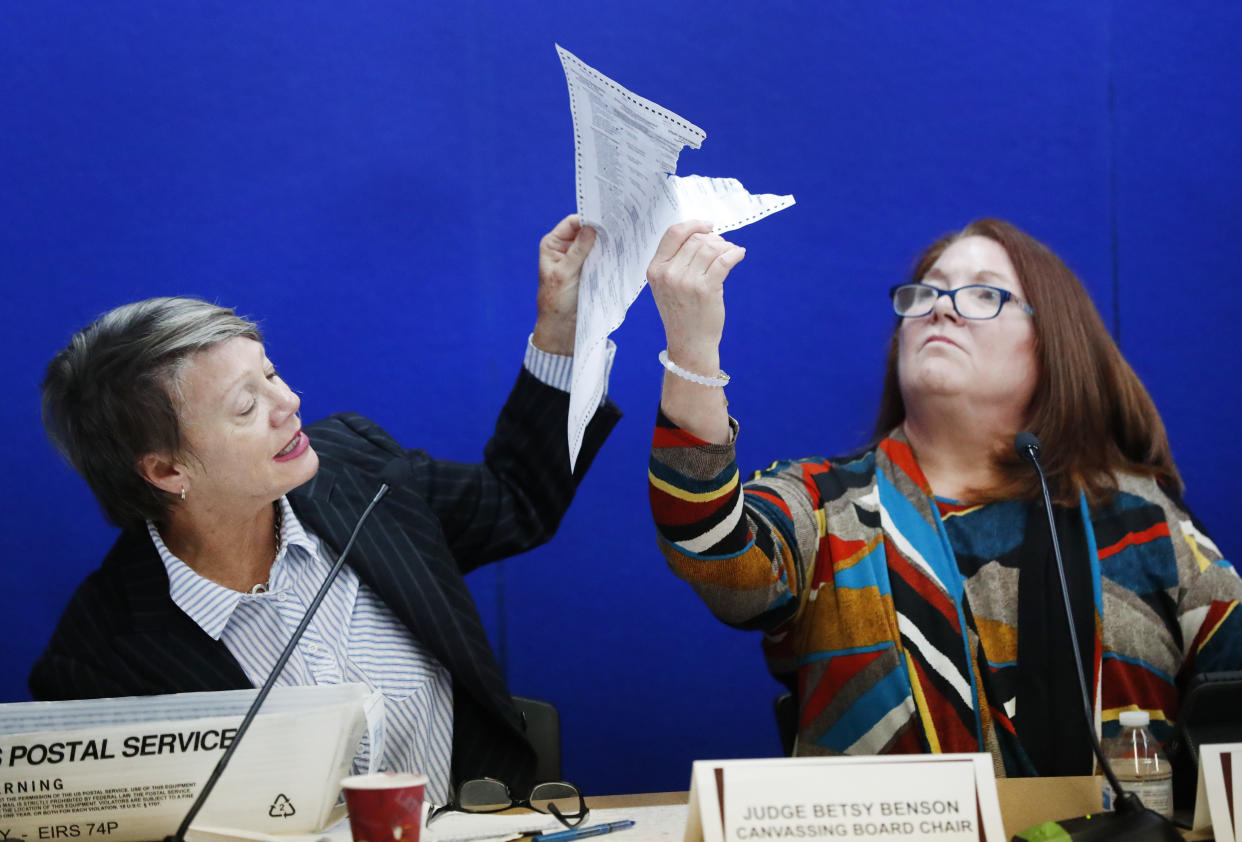How Florida’s recount will work

Let’s start with the basics of understanding the Florida recount.
First, it’s helpful to remember Florida has never conducted a statewide hand recount. The 2000 recount was conducted statewide by a machine count, with four counties participating in a hand recount: Miami-Dade, Broward, Palm Beach and Volusia. And those recounts were halted midprocess by the Supreme Court’s decision in Bush v. Gore.
But Florida is expected to proceed with a hand recount statewide for the U.S. Senate race and the contest for agriculture commissioner, once the results of the machine recount are reported Thursday afternoon. Scott, who had loudly protested the recount process and echoed President Trump’s apparently baseless charges that it would be tainted by fraud, saw his lead actually increase by 865 votes from the figure reported last Saturday, to 13,427. That is still within the margin — 0.25 percent — that will require a hand recount. The machine recount did not change the outcome for the race for governor between Rep. Ron DeSantis and Tallahassee Mayor Andrew Gillum. DeSantis appeared to be holding a lead that exceeded the threshold for a hand recount, but Gillum as of late Thursday afternoon had not conceded.
Ballots were cast in one of five ways. People could vote in Florida this year: through absentee voting, also known as voting by mail (VBM); by in-person early voting; by voting on election day; through a provisional ballot for voters who did not have state-approved ID or who may have gone to the wrong precinct; and through overseas and military voting.
Counties will not count all 8 million ballots by hand. That would take forever. They will be looking at one particular type of ballot, which involves overvotes and undervotes.
Overvotes and undervotes occur in the following way: A voter in Florida filled out a ballot by hand and turned it in to an election official for counting by machine, and the machine then read either more than one or less than one vote in any particular race.
Sometimes, the machine reads a ballot as not showing a vote for any candidate in a particular race. That might be because the voter did not intend to vote in that contest. Or it could be because the voter circled or underlined the name of a candidate or wrote an X next to it, rather than filling in the bubble according to instructions, or didn’t fully fill in the bubble. Any of those could result in an undervote for that race.

An overvote occurs when the machine reads the ballot as showing a vote for too many candidates in the same race. In the U.S. Senate race between Sen. Bill Nelson, the Democrat, and his challenger, Gov. Rick Scott, an overvote would mean that the machine read the ballot as showing a vote for both Nelson and Scott. The most common way this happens is a voter starting to mark the bubble for one candidate, realizing a mistake and then more fully filling in the other one. The machine reads both bubbles as being filled in, and it invalidates the vote in that race.
All ballots with overvotes and undervotes will be assessed by hand in a two-step process. County workers will sort through ballots, and if the actual intent of the voter isn’t obvious, volunteers for the campaigns involved in the recount can ask that the ballot be assessed by a canvassing board consisting of the local supervisor of elections, the chair of the county commissioners board and a county court judge.
There were an unusual number of undervotes in the U.S. Senate race: 31,529 statewide. Around 25,000 of those were in Broward County, according to the Tampa Bay Times. That has led many observers to speculate that the ballot design chosen by Broward County led many voters to overlook the Senate race, which appeared at the bottom of the left-hand column under a dense block of written instructions, while the governor’s race was in a much more prominent position at the top.
But it’s possible that some number of voters tried to mark a choice in the Senate race and it wasn’t registered by the machine process.
That could make a significant difference, because the number of undervotes in the Senate race is larger than the margin between the two candidates: Nelson trailed Scott by 12,562 votes as of Nov. 10, when counties reported their preliminary results. Meanwhile, Democrat Nikki Fried led the race for agriculture commissioner by 5,326 votes over Republican Matt Caldwell.
The other outstanding issue in the recount are some 5,000 ballots statewide that weren’t counted because the signature on the mail-in ballot did not match the signature on file with the state.
On Thursday morning, a federal judge granted partial relief to Democrats asking him to allow those signature-mismatch ballots to count. U.S. District Court Judge Mark Walker said voters whose ballots were thrown out for a mismatched signature could correct the problem and have their ballots counted, but only if they were “belatedly notified” that their ballot was thrown out.
Democrats had asked the judge to do away with the signature match requirement altogether and to count all 5,000 ballots that had been thrown out.
It’s not clear how many of the 5,000 or so disqualified ballots under signature match will be corrected and retroactively added to the totals. Republicans immediately appealed the decision.
The deadline for the hand recount to be finished is Sunday at noon.

_____
Read more from Yahoo News:
The CIA’s communications suffered a catastrophic compromise. It started in Iran.
Ending the Qatar blockade might be the price Saudi Arabia pays for Khashoggi’s murder
How Robert Mercer’s hedge fund profits from Trump’s hard-line immigration stance
Trump’s target audience for migrant caravan scare tactics: Women



